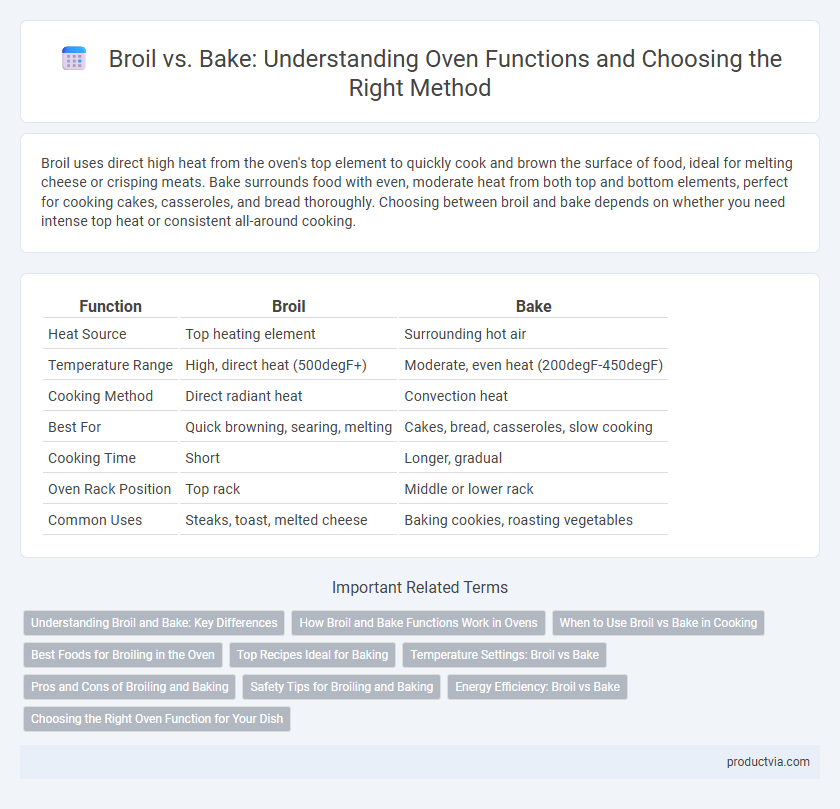Broil uses direct high heat from the oven's top element to quickly cook and brown the surface of food, ideal for melting cheese or crisping meats. Bake surrounds food with even, moderate heat from both top and bottom elements, perfect for cooking cakes, casseroles, and bread thoroughly. Choosing between broil and bake depends on whether you need intense top heat or consistent all-around cooking.
Table of Comparison
| Function | Broil | Bake |
|---|---|---|
| Heat Source | Top heating element | Surrounding hot air |
| Temperature Range | High, direct heat (500degF+) | Moderate, even heat (200degF-450degF) |
| Cooking Method | Direct radiant heat | Convection heat |
| Best For | Quick browning, searing, melting | Cakes, bread, casseroles, slow cooking |
| Cooking Time | Short | Longer, gradual |
| Oven Rack Position | Top rack | Middle or lower rack |
| Common Uses | Steaks, toast, melted cheese | Baking cookies, roasting vegetables |
Understanding Broil and Bake: Key Differences
Broil uses high, direct heat from the oven's top element to quickly cook and brown food, ideal for melting cheese or creating a crispy crust. Bake relies on consistent, surrounding heat from both top and bottom elements to cook food evenly, perfect for cakes, bread, and casseroles. Understanding these key differences ensures optimal cooking results by selecting the appropriate function for your recipe and desired texture.
How Broil and Bake Functions Work in Ovens
The broil function in ovens uses intense, direct heat from the top heating element to quickly cook or brown food, ideal for searing meats and melting toppings. In contrast, the bake function employs consistent, indirect heat circulating evenly around the food via both top and bottom heating elements, perfect for thorough cooking of cakes, casseroles, and bread. Understanding these heating methods helps optimize cooking results by selecting the appropriate function based on desired texture and cooking time.
When to Use Broil vs Bake in Cooking
Broil is ideal for cooking thin cuts of meat, seafood, or vegetables quickly at high heat to achieve a crisp, caramelized exterior, while bake is better suited for even, gentle cooking of casseroles, cakes, and bread. Use broil when you want to brown or char food surfaces without overcooking the interior. Choose bake for thorough, consistent cooking and rising when preparing delicate or dense dishes.
Best Foods for Broiling in the Oven
Broiling in the oven is ideal for cooking tender cuts of meat, such as steaks, chops, and fish fillets, offering a high-heat, direct cooking method that sears the surface for a crispy exterior while keeping the inside juicy. Vegetables like asparagus, bell peppers, and tomatoes also benefit from broiling, which enhances their natural sweetness and imparts a smoky flavor. This function is perfect for quickly caramelizing toppings on casseroles or melting cheese on dishes like French onion soup.
Top Recipes Ideal for Baking
Baking in an oven utilizes consistent, surrounding heat, making it ideal for recipes like cakes, bread, and casseroles that require even cooking throughout. Broiling exposes food to intense, direct top heat, perfect for quick-cooking items such as melting cheese on dishes or crisping the surface of meats. Top baking recipes include chocolate chip cookies, banana bread, and roasted vegetables, all benefiting from the oven's stable temperature and uniform heat distribution.
Temperature Settings: Broil vs Bake
Broil function in ovens typically operates at high, direct heat around 500degF to 550degF, ideal for quickly cooking or browning the surface of food. Bake settings use a lower, consistent temperature ranging from 200degF to 450degF, allowing for even heat distribution to cook food thoroughly. Temperature control in broiling targets intense top-down heat, while baking relies on surrounding air to evenly cook dishes.
Pros and Cons of Broiling and Baking
Broiling applies intense, direct heat from above, ideal for quickly cooking thin cuts of meat or caramelizing toppings, but it risks burning food if left unattended. Baking surrounds food with consistent, indirect heat, making it perfect for evenly cooked bread, casseroles, and desserts, though it requires longer cooking times. Choosing broil over bake depends on desired texture and cooking speed, with broiling offering faster results and baking providing thorough, gentle heat.
Safety Tips for Broiling and Baking
Broiling exposes food to high, direct heat from above, requiring careful placement of oven racks and constant supervision to prevent burning or fires. Baking involves indirect, consistent heat, reducing flare-up risks but still necessitates oven mitts and proper cookware to avoid burns. Always keep the oven door closed during broiling to maintain heat efficiency and use heat-resistant gloves when handling dishes in both functions to ensure safety.
Energy Efficiency: Broil vs Bake
Broiling uses intense, direct heat from the oven's top element, consuming energy rapidly but for a shorter duration, making it efficient for quick cooking tasks. Baking relies on moderate, even heat distribution from both top and bottom elements, resulting in longer cooking times and higher overall energy usage. Choosing broil over bake can reduce energy consumption when preparing thin cuts of meat or vegetables requiring fast, high-heat cooking.
Choosing the Right Oven Function for Your Dish
Broiling uses intense, direct heat from above to quickly cook or brown the surface of food, making it ideal for steaks, fish, and vegetables that benefit from a crispy exterior. Baking relies on consistent, indirect heat circulating around the food, perfect for evenly cooking cakes, bread, and casseroles. Selecting the right oven function depends on the desired texture and cooking time, with broil suited for high-heat, fast cooking and bake for slow, thorough heat distribution.
Broil vs Bake for Oven Function Infographic

 productvia.com
productvia.com